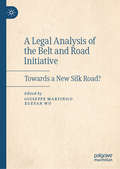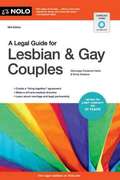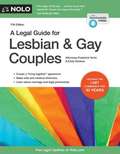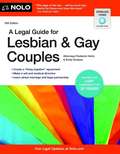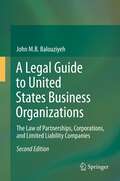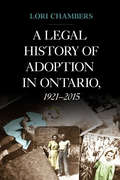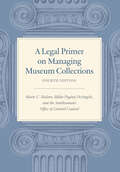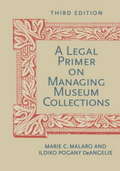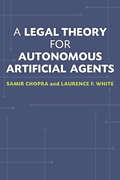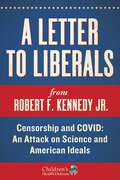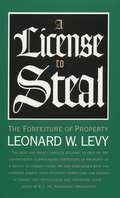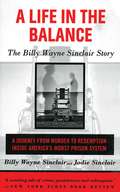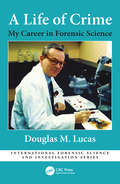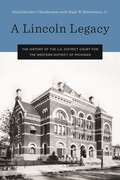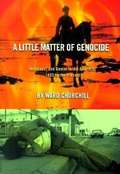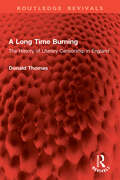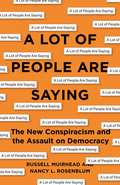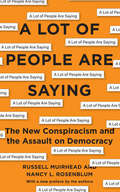- Table View
- List View
A Legal Analysis of the Belt and Road Initiative: Towards a New Silk Road?
by Giuseppe Martinico Xueyan WuWhat does the Belt and Road Initiative mean for the existing multilateral organisations? What can it represent for the future of the European Union in the long run? What is the role of hard and soft law in the functioning of the Initiative? What does it represent from a legal theory perspective? This book aspires to contribute to the international debate by gathering scholars with different backgrounds (legal theorists, public international lawyers, comparative lawyers) in a way that they can offer their inputs and observations concerning the Belt and Road Initiative.
A Legal Assessment of the Efficacy of Consultation with Indigenous Peoples: The Case of Brazil
by Catarina Woyames DreherThis book offers a novel perspective on consultation with indigenous peoples in projects of natural resource exploitation. Engaging with current debates in international law, the study introduces a multi-dimensional perspective on consultation understood to include self-determination and cultural rights. It analyzes evidence from several countries across the Americas and Africa and presents an original and in-depth case study of Brazil. The book assesses judicial and legislative cases, drawing on relevant literature, international treaties and supplementary information gained from expert interviews. This supports the work’s broader objective to explore legal facts as well as to evaluate the empirical evidence in light of theoretical considerations. It thereby expands the understanding of consultation as a right under national legal systems and considers practical ways on how to enforce domestic redress for avoiding legal indeterminacy. The conclusions of the analysis contribute to not only a better understanding of the subject matter but also showcase ways of how to improve the realities on the ground. The book puts forward a range of recommendations directed at national authorities, international organizations, development lenders and civil society to help improve the unsatisfactory present circumstances. The intended audience encompasses legal scholars, students, practitioners and journalists, as well as anyone interested in research on the realization of indigenous peoples’ rights and the role of international law in the 21st century.
A Legal Guide for Lesbian & Gay Couples
by Denis Clifford AttorneyThis practical guide is updated with the latest legal information and legislation that will help you and your same-sex partner protect and exercise your rights, and make sound decisions as a couple. A Legal Guide for Lesbian & Gay Couples covers these important subjects, and many more: making practical decisions about living together planning for medical emergencies -- making medical decisions for one another and taking care of each other's finances when one partner is incapacitated domestic partner benefits and how to obtain them buying property together providing for each other upon death practical and legal aspects of having and raising children marriage laws for all 50 states This edition of A Legal Guide for Lesbian & Gay Coupless is updated to provide the latest information on same-sex marriage, civil unions and domestic partnerships in the U.S., Canada and around the world, as well as all the recent developments in same-sex partnership law. Plus, create essential legal documents using the step-by-step instructions included with downloadable forms.
A Legal Guide for Lesbian & Gay Couples, 17th Ed.
by Emily Doskow Frederick HertzLaws affecting LGBT couples are changing rapidly, and while it's an exciting time for all gay and lesbian partners, keeping up with the myriad ways the shifting legal landscape touches your family life can be daunting. Now more than ever, it's important that you take the proper legal steps to define and protect your relationship in the eyes of the law. If you don't, you run the risk of being shut out of each other's lives and the lives of children you co parent in times of medical, financial or personal crisis.<P> Fortunately, this practical guide is updated with the latest legal information and legislation that will help you and your same sex partner protect and exercise your rights, and make sound decisions as a couple.<P> A Legal Guide for Lesbian & Gay Couples covers: * making practical decisions about living together<P> * planning for medical emergencies making medical decisions for one another and taking care * of each other's finances when one partner is incapacitated<P> * domestic partner benefits and how to obtain them<P> * buying property together<P> * providing for each other upon death<P> * practical and legal aspects of having and raising children<P> * marriage laws for all 50 states<P> The updated edition provides the latest information on same sex marriage, civil unions and domestic partnerships. Plus, create essential legal documents using the step by step instructions included.
A Legal Guide for Lesbian and Gay Couples
by Denis Clifford Emily Doskow Frederick HertzProtect your rights -- protect your relationship. Laws affecting LGBT couples are changing rapidly, and while its an exciting time for all gay and lesbian partners, keeping up with the myriad ways the shifting legal landscape touches your family life can be daunting. Now more than ever, its important that you take the proper legal steps to define and protect your relationship in the eyes of the law. If you dont, you run the risk of being shut out of each others lives -- and the lives of children you co- parent -- in times of medical, financial or personal crisis. Fortunately, this practical guide is updated with the latest legal information and legislation that will help you and your same-sex partner protect and exercise your rights, and make sound decisions as a couple. A Legal Guide for Lesbian & Gay Couples covers these important subjects, and many more: . making practical decisions about living together . planning for medical emergencies -- making medical decisions for one another and taking care of each others finances when one partner is incapacitated . domestic partner benefits and how to obtain them . buying property together . providing for each other upon death . practical and legal aspects of having and raising children . marriage laws for all 50 states The updated edition of A Legal Guide for Lesbian & Gay Couples is updated to provide the latest information on same-sex marriage, civil unions and domestic partnerships in the U. S. , Canada and around the world, as well as all the recent developments in same- sex partnership law. Plus, create essential legal documents using the step-by-step instructions included. --Download forms for book at nolo. com
A Legal Guide to United States Business Organizations: The Law of Partnerships, Corporations, and Limited Liability Companies
by John M. BalouziyehThis volume provides an overview of United States federal and state law governing business organizations. The chapters take the reader through a step-by-step exposition of the most basic sole proprietorships to the most complex multi-tiered conglomerates. Among the business organizations treated are partnerships with their various modalities (general partnerships, limited partnerships, limited liability partnerships), corporations (including closely held corporations, public corporations and other variations) and limited liability companies. The case law and statutes governing the full menu of business organizations are systematically analyzed and presented. Leading cases at both the federal and state level as well as model legislation such as the Uniform Partnership Act and enacted legislation are further examined. Other topics covered include Agency and partnerships, Accounting, taxation and finance, Startup corporations and venture capital, Fiduciary duties and shareholder control, Mergers and acquisitions.
A Legal History of Adoption in Ontario. 1921-2015
by Lori Chambers The Osgoode SocietyLori Chambers' fascinating study explores the legal history of adoption in Ontario since the passage of the first statute in 1921. This volume explores a wide range of themes and issues in the history of adoption including: the reasons for the creation of statutory adoption, the increasing voice of unmarried fathers in newborn adoption, the reasons for movement away from secrecy in adoption, the evolution of step-parent adoption, the adoption of Indigenous children, and the growth of international adoption. Unlike other works on adoption, Chambers focuses explicitly on statutes, statutory debates and the interpretation of statues in court. In doing so, she concludes that adoption is an inadequate response to child welfare and on its own cannot solve problems regarding child neglect and abuse. Rather, Chambers argues that in order to reform the area of adoption we must first acknowledge that it is built upon social inequalities within and between nations.
A Legal History of Mississippi: Race, Class, and the Struggle for Opportunity
by Joseph A. RanneyIn A Legal History of Mississippi: Race, Class, and the Struggle for Opportunity, legal scholar Joseph A. Ranney surveys the evolution of Mississippi’s legal system and analyzes the ways in which that system has changed during the state’s first two hundred years. Through close research, qualitative analysis, published court decisions, statutes, and law review articles, along with unusual secondary sources including nineteenth-century political and legal journals and journals of state constitutional conventions, Ranney indicates how Mississippi law has both shaped and reflected the state’s character and, to a certain extent, how Mississippi’s legal evolution compares with that of other states.Ranney examines the interaction of Mississippi law and society during key periods of change including the colonial and territorial eras and the early years of statehood when the legal foundations were laid; the evolution of slavery and slave law in Mississippi; the state’s antebellum role as a leader of Jacksonian legal reform; the unfolding of the response to emancipation and wartime devastation during Reconstruction and the early Jim Crow era; Mississippi’s legal evolution during the Progressive Era and its legal response to the crisis of the Great Depression; and the legal response to the civil rights revolution of the mid-twentieth century and the cultural revolutions of the late twentieth century. Histories of the law in other states are starting to appear, but there is none for Mississippi. Ranney fills that gap to help us better understand the state as it enters its third century.
A Legal History of the Civil War and Reconstruction
by Laura F. EdwardsAlthough hundreds of thousands of people died fighting in the Civil War, perhaps the war's biggest casualty was the nation's legal order. A Nation of Rights explores the implications of this major change by bringing legal history into dialogue with the scholarship of other historical fields. Federal policy on slavery and race, particularly the three Reconstruction amendments, are the best-known legal innovations of the era. Change, however, permeated all levels of the legal system, altering Americans' relationship to the law and allowing them to move popular conceptions of justice into the ambit of government policy. The results linked Americans to the nation through individual rights, which were extended to more people and, as a result of new claims, were reimagined to cover a wider array of issues. But rights had limits in what they could accomplish, particularly when it came to the collective goals that so many ordinary Americans advocated. Ultimately, Laura F. Edwards argues that this new nation of rights offered up promises that would prove difficult to sustain.
A Legal Primer on Managing Museum Collections, Fourth Edition
by Marie C. Malaro Ildiko DeAngelis SI Office of General CounselA new edition of the bible of U.S. collections management—now updated for the 21st-century museum professional or Museum Studies student!This is the only comprehensive discussion of the legal questions faced by museums as they acquire, use, and refine their collections.This fully revised and expanded fourth edition addresses a thorough range of legal developments museums face, including new developments in the digital age and under new repatriation regulations. This approachable, easy-to-follow guide provides:Major updates on deaccessioning and copyright and fair useNew chapters on ethical returns and shared stewardship Real-life and hypothetical lawsuit case studiesSamples from museum collection policies Templates to help with document writingSuggestions for preventing legal problemsFootnotes with more indepth discussion of relevant casesThe book covers a wide range of issues, including nonprofit status, fraud, copyright, loans, documentation, accessioning and deaccessioning, international exhibitions, and cultural heritage concerns. The authorative A Legal Primer on Managing Museum Collections offers detailed explanations of the law that make it a go-to book for any museum professional.
A Legal Primer on Managing Museum Collections, Third Edition
by Ildiko Deangelis Marie C. MalaroHailed when it was first published in 1985 as the bible of U.S. collections management, A Legal Primer on Managing Museum Collections offers the only comprehensive discussion of the legal questions faced by museums regarding collections. This revised and expanded third edition addresses the many legal developments--including a comprehensive discussion of stolen art and the international movement of cultural property, recent developments in copyright, and the effects of burgeoning electronic uses--that have occurred during the past twenty-five years. An authorative, go-to book for any museum professional, Legal Primer offers detailed explanations of the law, suggestions for preventing legal problems, and numerous case studies of lawsuits involving museum collections.
A Legal Theory for Autonomous Artificial Agents
by Samir Chopra Laurence F. WhiteAs corporations and government agencies replace human employees with online customer service and automated phone systems, we become accustomed to doing business with nonhuman agents. If artificial intelligence (AI) technology advances as today's leading researchers predict, these agents may soon function with such limited human input that they appear to act independently. When they achieve that level of autonomy, what legal status should they have?
A Letter to Liberals: Censorship and COVID: An Attack on Science and American Ideals (Children’s Health Defense)
by Robert F. Kennedy Jr.A leading Democrat challenges his party to return to liberal values and evidence-based science Democrats were the party of intellectual curiosity, critical thinking, and faith in scientific and liberal empiricism. They once took pride in understanding how to read science critically, exercising healthy skepticism toward notoriously corrupt entities like the drug companies that brought us the opioid crisis, and were outraged by the phenomenon of &“agency capture&” and the pervasive control of private interests over Congress, the media, and the scientific journals. During the COVID pandemic, these attitudes have taken a back seat to blind faith in government mandates and countermeasures driven by pharmaceutical companies and captive federal agencies, promoted by corporate media, and cynically exploiting the fears of the American people. A Letter to Liberals is Robert F. Kennedy Jr.&’s, challenge to &“lockdown liberalism&’s&” embrace of policies that are an affront to once cherished precepts. Kennedy invites readers to look at the data in order to answer questions such as:Did COVID vaccines really save millions and end the pandemic?Why were the lowest COVID death rates in countries and states that relied on therapeutic drugs, and in countries with the lowest vaccination rates?Did vaccines prevent infection or transmission as officials promised?Why do COVID vaccines appear to show &“negative efficacy&”—making the vaccinated more susceptible to COVID.Why does the most reliable data suggest that COVID vaccines do not lower the risk of death and hospitalization.Should government technocrats be partnering with media and social media titans to censor and suppress the questioning of government policies?And why have so many liberals abandoned fundamental Constitutional principles in their headlong rush to embrace pandemic policies pushed by captured bureaucrats, feckless politicians, a compromised news media, and Big Pharma?In his November 2021 book The Real Anthony Fauci, which sold over 1,000,000 copies, Kennedy made predictions that have matured from &“conspiracy theories&” to proven facts. Among these: Masks Are Ineffective and DangerousSocial Distancing Was Not Science-BasedSchool Closures Were Not Science-BasedLockdowns Were CounterproductiveVaccinating Children Causes More Harm and Death Than It AvertsOfficials Wrongly Used PCR Tests to Justify the CountermeasuresCOVID-19 May Have Come from Wuhan LabNatural Immunity is Superior to Vaccine Immunity Kennedy throws down the gauntlet for the kind of vigorous scientific debate that liberals have long stood for and strives to ensure that unbiased honesty and well-researched thought is brought to bear on one of the most important and still unfolding chapters in human history.
A Liberal Theory of Property
by Hanoch DaganProperty enhances autonomy for most people, but not for all. Because it both empowers and disables, property requires constant vigilance. A Liberal Theory of Property addresses key questions: how can property be justified? What core values should property law advance, and how do those values interrelate? How is a liberal state obligated to act when shaping property law? In a liberal polity, the primary commitment to individual autonomy dominates the justification of property, founding it on three pillars: carefully delineated private authority, structural (but not value) pluralism, and relational justice. A genuinely liberal property law meets the legitimacy challenge confronting property by expanding people's opportunities for individual and collective self-determination while carefully restricting their options of interpersonal domination. The book shows how the three pillars of liberal property account for core features of existing property systems, provide a normative vocabulary for evaluating central doctrines, and offer directions for urgent reforms.
A License to Steal
by Leonard W. LevyLeonard Levy traces the development and implementation of forfeiture and contends that it is a questionable practice, which, because it is so often abused, serves only to undermine civil society. Arguing that civil forfeiture is unconstitutional, Levy provides examples of the victimization of innocent people and demonstrates that it has been used primarily against petty offienders rather than against its original targets, members of organized crime.
A Life and Death Decision: A Jury Weighs the Death Penalty
by Scott E. SundbyA gripping exploration of a jury's members' perspectives on the most wrenching decision: the death sentence With a life in the balance, a jury convicts a man of murder and now has to decide whether he should be put to death. Twelve people now face a momentous choice.Bringing drama to life, A Life and Death Decision gives unique insight into how a jury deliberates. We feel the passions, anger, and despair as the jurors grapple with legal, moral, and personal dilemmas. The jurors' voices are compelling. From the idealist to the "holdout," the individual stories—of how and why they voted for life or death—drive the narrative. The reader is right there siding with one or another juror in this riveting read.From movies to novels to television, juries fascinate. Focusing on a single case, Sundby sheds light on broader issues, including the roles of race, class, and gender in the justice system. With death penalty cases consistently in the news, this is an important window on how real jurors deliberate about a pressing national issue.
A Life in the Balance: The Billy Wayne Sinclair Story, A Journey from Murder to Redemption Inside America's Worst Prison System
by Billy Wayne Sinclair Jodie SinclairSentenced to death in 1965 at age twenty for an unpremeditated murder during the bungled holdup of a convenience store, Billy Wayne spent his first seven prison years on death row. When the death penalty was abolished, his sentence was life. Three-and-a-half decades later, Billy Wayne is still behind bars-feared by many politicians and prison officials for his well-known incorruptibility and unrelenting crusade for prison reform. This is his memoir.A Life in the Balance begins with an almost unbearable account of his early years-when he was so abused by his father one wonders how he survived-and his "escape" into a crowd of hooligans, which led him to the fateful day in 1965 when he held up the convenience store. His story takes you behind the metal doors of the Angola State Penitentiary to reveal the brutal truth of life inside. Here you will meet Billy Ray, Billy Wayne's blood brother; old Emmitt Henderson, who died of prison neglect; Jamie Parks, a seventeen-year-old kid whose fate was sealed the day he arrived in Angola; Big Mick, who ran drugs in the prison to earn money to put his handicapped sister through college; Wilbert Rideau, Billy Wayne's coeditor on The Angolite; the Dixie Mafia; and Richard Clark Hand, the young lawyer who took on Billy Wayne's case and has been fighting for his release for thirty years.
A Life of Crime: My Career in Forensic Science (International Forensic Science and Investigation)
by Douglas LucasA Life of Crime: My Career in Forensic Science chronicles the career and experiences of world-renowned forensic scientist, Dr. Douglas Lucas. It is the culmination of his decades-worth of work in the field, developing innovative techniques that have revolutionized several aspects of forensic science. It is part professional reference, part career guide, part instructive reference for students wishing to entering the to enter the field, and wholly autobiographical. Dr. Lucas chronicles a number of the high-profile cases he’s worked on firsthand. This includes both the logistical problem-solving of case management—how to process and handle the evidence—in addition to the testing, analysis and processes he went through, and developed, along the way. Such cases include mass disaster plane crashes, arson, IEDs and explosives, poisonings, missing persons, and homicides, to name just a few. Dr. Lucas has encountered and seen just about everything a forensic professional can see. In addition to the in-depth discussion, development, and philosophy of forensic science as a discipline, the book also discusses the balance of personal and professional life. This is a vital, but little thought of aspect that becomes a conspicuous reality of working in the field: namely, delving into the science, and dealing with those personal emotions, work conflicts, and ethical conundrums that a professional regularly encounters. Forensic professionals, investigators, and students—regardless of background or discipline—will find this a fascinating look "behind the curtain" at one of the most decorated, innovative, and respected members of the field over the last 50 years.
A Life-Centered Approach to Bioethics
by Lawrence E. JohnsonApproaches bioethics on the basis of a conception of life and what is needed for the affirmation of its quality in the most encompassing sense. Johnson applies this conception to discussions of controversial issues in bioethics including euthanasia, abortion, cloning and genetic engineering. His emphasis is not on providing definitive solutions to all bioethical issues but on developing an approach to coping with them that can also help us deal with new issues as they emerge. The foundation of this discussion is an extensive examination of the nature of the self and its good and of various approaches to ethics. His bioethic is integrally related to his well-known work on environmental philosophy. The book also applies these principles on an individual level, offering a user-friendly discussion of how to deal with ethical slippery slopes and how and where to draw the line when dealing with difficult questions of bioethics.
A Lincoln Legacy: The History of the U.S. District Court for the Western District of Michigan (Great Lakes Books Series)
by David Gardner Chardavoyne Hugh W. JrA Lincoln Legacy: The History of the U.S. District Court for the Western District of Michigan by David Gardner Chardavoyne with Hugh W. Brenneman, Jr. provides the first and only comprehensive examination of the history of the United States federal courts in the Western District of Michigan. The federal courts were established by the U.S. Constitution to adjudicate disputes involving federal laws, disputes between litigants from different states involving state and federal laws, and to punish violations of criminal laws passed by Congress. During the Civil War, Abraham Lincoln signed legislation creating two federal districts in the state of Michigan: the Eastern and Western Districts—the latter of which is headquartered in Grand Rapids and which now encompasses the western half of the Lower Peninsula and all of the Upper Peninsula. With the rapid expansion of legislation passed by Congress, the increasing mobility of society, and the growth of interstate commerce, the federal courts have assumed an important and sometimes dominant role in major litigation today. In A Lincoln Legacy, Chardavoyne tracks the history of these courts over eleven chapters, from their creation by the Northwest Ordinance of 1787 to 2020. He discusses the changes in society that drove the evolving federal litigation and some significant cases heard in the Western District. Additionally, fifteen appendices are included in the book, listing of all the federal circuit and district judges in the Western District; commissioners; magistrate judges and bankruptcy judges; U.S. Attorneys; clerks of the courts; and more. Chardavoyne also identifies auxiliary offices and organizations revolving around the federal court that play a major role in its activities (e.g., the U.S. Attorney’s Office, the Federal Public Defender’s Office, the Federal Bar Association, etc.). A Lincoln Legacy provides a thorough examination of the history of the federal courts of Western Michigan. It will appeal to those learning and practicing law, as well as those with an interest in Michigan history.
A Little Matter of Genocide: Holocaust and Denial in the Americas, 1492 to the Present
by Ward ChurchillWard Churchill has achieved an unparalleled reputation as a scholar-activist and analyst of indigenous issues in North America. Here, he explores the history of holocaust and denial in this hemisphere, beginning with the arrival of Columbus and continuing on into the present. He frames the matter by examining both "revisionist" denial of the Nazi-perpatrated Holocaust and the opposing claim of its exclusive "uniqueness," using the full scope of what happened in Europe as a backdrop against which to demonstrate that genocide is precisely what has been-and still is-carried out against the American Indians. Churchill lays bare the means by which many of these realities have remained hidden, how public understanding of this most monstrous of crimes has been subverted not only by its perpetrators and their beneficiaries but by the institutions and individuals who perceive advantages in the confusion. In particular, he outlines the reasons underlying the United States's 40-year refusal to ratify the Genocide Convention, as well as the implications of the attempt to exempt itself from compliance when it finally offered its "endorsement. " In conclusion, Churchill proposes a more adequate and coherent definition of the crime as a basis for identifying, punishing, and preventing genocidal practices, wherever and whenever they occur. Ward Churchill (enrolled Keetoowah Cherokee) is Professor of American Indian Studies with the Department of Ethnic Studies at the University of Colorado-Boulder. A member of the American Indian Movement since 1972, he has been a leader of the Colorado chapter for the past fifteen years. Among his previous books have been Fantasies of a Master Race, Struggle for the Land, Since Predator Came, and From a Native Son.
A Long Time Burning: The History of Literary Censorship in England (Routledge Revivals)
by Donald ThomasCensorship of the written word has proved a constant source for debate and argument. To cut or not to cut is a question with a long and fascinating history. First published in 1969, A Long Time Burning is an account of the political, religious, and moral censorship of literature, in the context of English literary history. It is principally concerned with the evolution of a modern pattern of censorship between the abolition of licensing in 1695 and the late Victorian period. The author outlines the motives and methods of censorship, illustrating these by more detailed discussion of such cases as those involving Edmund Curll, John Wilkes, Thomas Paine, William Hone, Richard Carlile, William Dugdale and Henry Vizetelly. The unofficial trade in banned books and the campaigns of the Proclamation Society; the Society for the Suppression of Vice, and the National Vigilance Association are described with the aid of some previously unpublished material.The book includes an anthology of illustrative material, quoting extracts from publications banned at various times and for various reasons. Pages from such books as Venus in the Cloister are reprinted for the first time in more than two centuries, while the other documents range from the Blasphemy Act of 1698 to a prosecution brought under the Race Relations Act of 1965.
A Lot of People Are Saying: The New Conspiracism and the Assault on Democracy
by Nancy L. Rosenblum Russell MuirheadHow the new conspiracists are undermining democracy—and what can be done about itConspiracy theories are as old as politics. But conspiracists today have introduced something new—conspiracy without theory. And the new conspiracism has moved from the fringes to the heart of government with the election of Donald Trump. In A Lot of People Are Saying, Russell Muirhead and Nancy Rosenblum show how the new conspiracism differs from classic conspiracy theory, why so few officials speak truth to conspiracy, and what needs to be done to resist it.Classic conspiracy theory insists that things are not what they seem and gathers evidence—especially facts ominously withheld by official sources—to tease out secret machinations. The new conspiracism is different. There is no demand for evidence, no dots revealed to form a pattern, no close examination of shadowy plotters. Dispensing with the burden of explanation, the new conspiracism imposes its own reality through repetition (exemplified by the Trump catchphrase “a lot of people are saying”) and bare assertion (“rigged!”).The new conspiracism targets democratic foundations—political parties and knowledge-producing institutions. It makes it more difficult to argue, persuade, negotiate, compromise, and even to disagree. Ultimately, it delegitimates democracy.Filled with vivid examples, A Lot of People Are Saying diagnoses a defining and disorienting feature of today’s politics and offers a guide to responding to the threat.
A Lot of People Are Saying: The New Conspiracism and the Assault on Democracy
by Nancy L. Rosenblum Russell MuirheadHow the new conspiracists are undermining democracy—and what can be done about itConspiracy theories are as old as politics. But conspiracists today have introduced something new—conspiracy without theory. And the new conspiracism has moved from the fringes to the heart of government with the election of Donald Trump. In A Lot of People Are Saying, Russell Muirhead and Nancy Rosenblum show how the new conspiracism differs from classic conspiracy theory, how it undermines democracy, and what needs to be done to resist it.
A Man to Slay Dragons
by Meagan MckinneyThe ad in the mercenary magazine High Risk was clear. Someone wanted a gun-for-hire. FBI hate crime specialist Liam Jameson is assigned to investigate.
